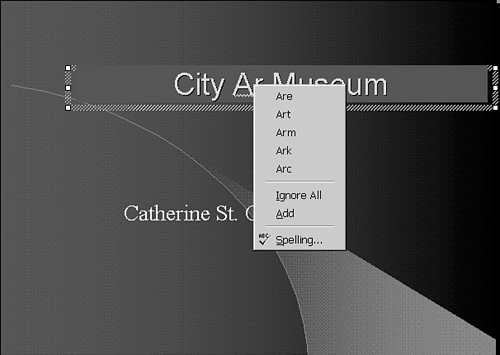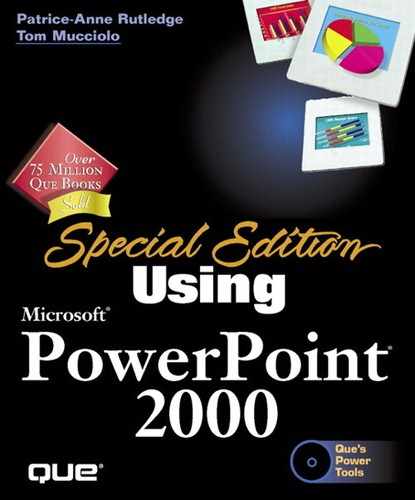Checking Spelling and Style
PowerPoint's spelling and style checkers can help ensure a quality presentation that is error-free and easy to read. To set options for spelling and style checks, select Tools, Options and go to the Spelling and Style tab. Figure 3.16 illustrates this tab.
Figure 3.16. You can automate spell checking in PowerPoint.

You can choose any of the following spelling options:
Check spelling as you type Underlines each suspected spelling error as you type it.
Hidespelling errors in this document Doesn't display underlining for suspected spelling errors.
Always suggest corrections Suggests possible correct spelling options.
Ignore words in UPPERCASE Skips any word that is all uppercase in the spell-check process.
Ignore words with numbers Skips any word that includes a number in the spell-check process.
Setting Style Options
If you also want to check style, select the Check style check box and click the Style Options button. This opens the Style Options dialog box, shown in Figure 3.17.
Caution
Although having PowerPoint search for potential style errors can help you find mistakes you wouldn't otherwise notice, be careful to look closely at the changes it suggests rather than just automatically accepting all style changes. Sometimes automation can yield unusual results.
On the Case and End Punctuation tab, you can select the default case and end punctuation styles for your presentation slide titles and body text. Options include the capability to:
Set Slide title style to Sentence case, lowercase, UPPERCASE, or Title Case (the default).
Set Body text style to Sentence case (the default), lowercase, UPPERCASE, or Title Case.
Set Slide title punctuation to either Paragraphs have punctuation (the default) or Paragraphs do not have punctuation.
Set Body punctuation to Paragraphs have punctuation, Paragraphs do not have punctuation, or Paragraphs have consistent punctuation (the default).
Select the check boxes next to all options for which you want PowerPoint to search and choose the default from the drop-down list.
Tip
If you want to place a character other than a period at the end of the slide title or body text, enter the appropriate characters in the Slide Title or Body Text Edit boxes in the End Punctuation group box. For example, you may want to use a colon instead of a period in some cases.
On the Visual Clarity tab (see Figure 3.18), you can view and revise the existing defaults for font clarity and presentation legibility.
In this tab you can set the
Maximum number of fonts
Minimum point size for title text
Minimum point size for body text
Maximum number of bullets
Maximum number of lines per title and per bullet
Figure 3.18. PowerPoint also can look for common style errors.

The Visual Clarity tab already includes default selections for these options that are based on basic design principles, but you can change any settings in the adjacent drop-down lists. When you run PowerPoint's spelling checker, it looks for violations of these constraints.
Caution
Even though you can change these defaults to suit your needs, consider carefully before doing so. Exceeding the recommended number of fonts and bullets and changing to overly small or overly large fonts can make your presentation difficult to read.
Running a Spelling and Style Check
After you've set the spelling and style options you want, you can check your presentation.
If you set the option to have PowerPoint check spelling as you type, you immediately know when you've potentially misspelled a word. PowerPoint underlines all suspected misspellings, as shown in Figure 3.19.
Figure 3.19. Underscored text indicates a potential spelling error.

You can either fix the error yourself, or right-click to see some suggested alternatives from which to choose. Figure 3.20 illustrates some suggestions.
 Is PowerPoint missing some of your spelling errors?
See the Troubleshooting section at the end of the chapter.
Is PowerPoint missing some of your spelling errors?
See the Troubleshooting section at the end of the chapter.
 Is PowerPoint missing some of your grammar errors?
See the Troubleshooting section at the end of the chapter.
Is PowerPoint missing some of your grammar errors?
See the Troubleshooting section at the end of the chapter.
Figure 3.20. PowerPoint offers suggested spellings for you.

You can also spell-check your entire presentation all at once. To do so, follow these steps:
When PowerPoint encounters an error, it displays the Spelling dialog box, shown in Figure 3.21.
The Not in Dictionary field highlights the misspelled word and the Change To field suggests the most likely alternative. The Suggestions box also provides additional alternatives.
Select the correct spelling or enter it manually in the Change To field.
The Spelling dialog box also includes several buttons that provide other options:
Ignore Ignores the individual suggested change and continues checking spelling.
Ignore All Ignores all instances of the suggested change in the presentation and continues checking spelling.
Change Changes the individual misspelled word to the spelling offered in the Change To field.
Change All Changes all instances of the misspelled word to the spelling offered in the Change To field.
Add Adds the suspect word to the custom dictionary as a correctly spelled word.
AutoCorrect Adds the misspelled word and its corrected version to the AutoCorrect list.
Note
PowerPoint also targets unknown words as spelling errors, such as a person's name, a company name, or a product. Be sure to check carefully for these and add the names and words you commonly use in presentations to the dictionary.
When PowerPoint finishes checking spelling, it informs you with another dialog box.


